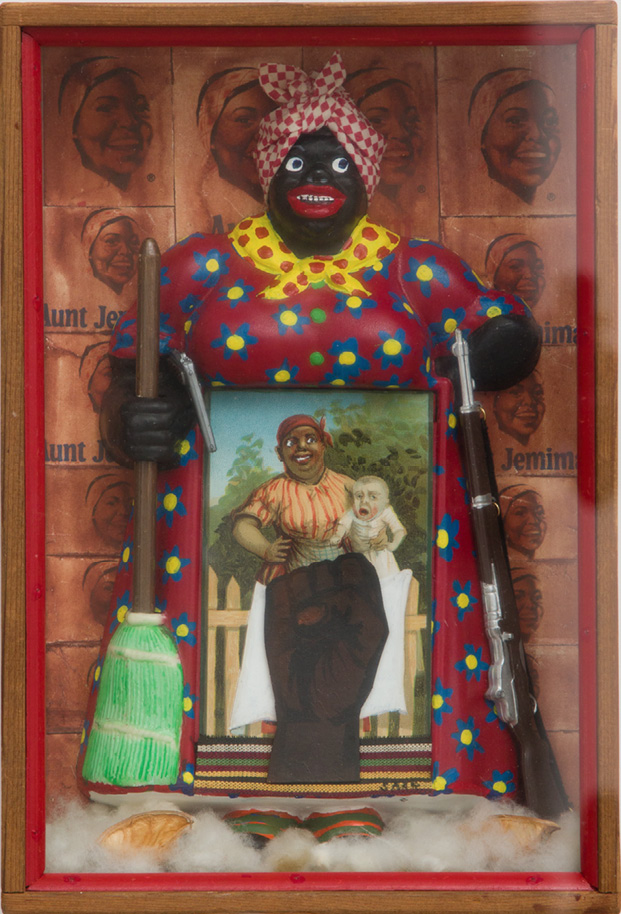How do you disappear when you’re already invisible? The unnamed narrator/protagonist in Ralph Ellison’s Invisible Man (1952) would answer by instead choosing to reappear to awaken sleepwalkers from their racist straightjacket. Similarly, selected artists in the traveling exhibition Soul of a Nation: Art in the Age of Black Power 1963-1983, now at the Broad in Los Angeles, interrogate the establishment’s cultural myopia, producing an unapologetically black aesthetic.
The show includes pieces by Los Angeles artists who benefited from the protesting of the Black Arts Council, a patrons collective founded by the late Cecil Fergerson and Claude Booker. Among these was John Outterbridge. His mixed-media Traditional Hang Up (Containment Series) (1969), shaped like a capital letter “T”, appropriates colors of the American flag with images of stars shaped like bombing planes. Such juxtaposition correlates with the domestic and foreign policy contradictions described by the antiwar movement protestors of the day, who were critical of imperialistic motives of U.S. involvement in the Vietnam War (commonly referred to as the American War by the Vietnamese). The tanned globe-shaped faces are attached horizontally as if trapped, scared and silenced. Ultimately, Traditional Hang-up assaults paradigms justifying exploitation and colonialism in the name of capitalism and democracy.
A similarly themed work, The Devil and his Game (1970) by Kay Brown, co-founder of New York-based artist collective, Where We At! Black Women Artists Inc., renders an image of a devil, with pitchfork at his shoulder. Sitting on a globe, this malevolent archetype (depicted as Nixon) wears an Uncle Sam hat. A checkerboard image tilts upward, forming a background for the fearful glances of black children. Images of Malcolm X and Dr. Martin Luther King Jr. overlook the scene and suggest that the future of black folk is hopeless as long as U.S. foreign policy renders mute critical visionary voices that will not play the game by the colonizer’s rules.
Significantly, the ideals of Black Power and resistance to oppression are expressed in Elizabeth Catlett’s mahogany Black Unity (1968), which reads frontally as a raised fist. However, the back of the work reveals a stylized suggestion of two sculpted African faces joined, arguing for unity in resistance, as internal fighting among the colonized poisons the possibility of successful struggle.
Uncompromising in addressing the problems encountered by black folk and offering solutions in a technically excellent manner were the members of AfriCOBRA (African Commune of Bad Relevant Artists). Those seven included in Soul of a Nation are founding members of 1968—Jeff Donaldson, Wadsworth Jarrell, Barbara Jones-Hogu, Jae Jarrell and Gerald Williams—along with Carolyn Lawrence and Nelson Stevens, who joined in 1969.
Jones-Hogu’s screenprint on paper, Unite (1971), embodies several ideals of the Black Power movement. The images of black men and women standing together in unity identify with the African struggle for freedom. Hogu’s title is programmatic in that it offers a positive solution to the individual, local, national and international problems facing black people throughout the diaspora. The use of such Kool-Aid colors as cherry and grape, along with brown and black earth tones, connotes strong emotions related to gaining one’s freedom through struggle. It also reaffirms a principle of AfriCOBRA regarding the wardrobe colors with which blacks proudly adorn themselves. The masterful composition aligns the letters of “Unite” in parallel with fists raised high, referencing the 1968 Summer Olympic gold medal ceremony in Mexico City, where Tommie Smith and John Carlos raised their fists in a public statement of protest for the entire world to witness.
Of additional significance, Hogu’s depiction of the Afro-adorned figures, correlating to the Black Panther party members, who also wore Afros, affirms black pride, freedom and self-determination. Founded in 1966 by Huey P. Newton and Bobby Seale, the Party developed a philosophy-based revolutionary nationalism and formed chapters throughout the United States. They developed food, health and education programs serving black communities as well as a program of community patrol and protection with the goal of preventing police brutality.
Ultimately, “Soul of a Nation” inspires courage to ask questions and opposes conformity in the midst of social and economic contradictions. It offers a compelling message of artistic freedom by any means necessary.




















0 Comments